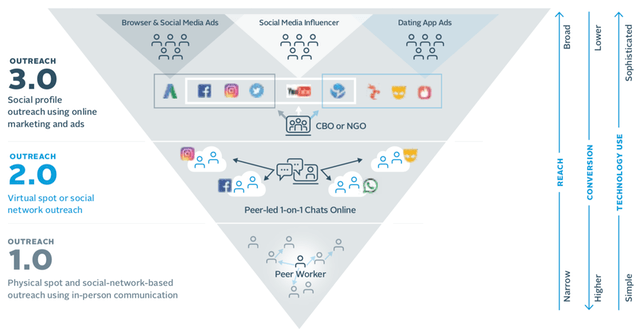Wayan Vota, Digital Health Director, IntraHealth International
This blog post was original published here on ICTworks.org.
In the Going Online to Accelerate the Impact of HIV Programs vision from the LINKAGES project, online outreach approaches were categorized into cumulative generations of outreach.
- Outreach 1.0: Traditional physical outreach where HIV program staff go to physical locations to reach members of the target audience or use physical networks to reach constituents.
- Outreach 2.0: Using online platforms and virtual locations to engage virtual network to find people at risk for HIV online and engage them in one-on-one chats to increase offline uptake of HIV services.
- Outreach 3.0: Uses online targeted advertising and promotions by personalities on social media (called social media influencers) with large followings among the target audiences.
This framework helps identity where audiences (and programs) are in terms of technology use, where they can go in the future, and the considerations we need to take into account when introducing new online outreach approaches that can broaden our reach.
Online Outreach Methods
The Going Online vision categorizes online outreach into three methods: social network outreach, social influencer outreach, and social profile outreach.
Ideally, these approaches should be used in combination with varying levels of intensity based on the relative value of each approach and its impact on reaching program targets. Some of these approaches may be best suited for large HIV programs because they require more sophisticated use of online advertising platforms and relationships with technology partners.
Social Network Outreach
Use online networks to reach and engage populations at risk for HIV through one-on-one chats on online or virtual platforms. This approach can be implemented by training existing or new outreach staff to contact their peers and additional networks online or through untrained community members who can mobilize their online friends to uptake HIV testing with incentives.
Features
-
-
- High engagement with clients
- Contributes to high conversion to uptake of HIV services
- Limited in reach
- Effectiveness depends on outreach workers’ skills and existing networks
-
Social Influencer Outreach
Engage influential, credible, and well-connected individuals as important partners in online outreach. Influencers include the “instafamous” and powerful trendsetters, established campaigns and pages that have the capacity to offer instant trust among target audiences, or online gate- keepers who can provide access to large private or closed online networks of populations at risk for HIV.
Features
-
-
- Low to medium engagement with clients
- Effective for breaking down complex topics for broad audiences
- Effective for establishing brand identity and trust among broader target audiences
- Effectiveness depends on authenticity, dedication, reach, and skill of influencers
-
Social Profile Outreach
Use online advertising across social media, dating apps, websites and search engines to reach populations at risk for HIV with increasing precision based on their demographics, interests, and the content of their online activity. Use the built-in analytics of social media platforms to track how specific subgroups respond to different targeted messages and how frequently they act by getting tested and entering treatment.
Features
-
-
- High reach, low engagement with clients
- Effective for attracting clients outside known networks
- Can support brand awareness and credibility
- Effectiveness depends on pre-existing knowledge about HIV and demand for HIV services
-
Social influencer outreach 3.0 example from Indonesia

The LINKAGES program in Jakarta – UpdateStatus.ID – uses three online outreach approaches to promote an online reservation system that helps link clients to HIV services in Indonesia. Since the launch of Update Status in July 2018, social media influencers have helped establish the online presence of the campaign and reach people at high risk for HIV.
Community service organizations and a community advisory team helped select and invite 50 influencers to an event where they learned about the program and promoted the website to their followers. After the event, two influencers launched additional promotions.
The outcomes of these influencer promotions are evident by the incoming website traffic, where a spike is found near the event on 8 July and during the influencer campaigns in late September. Of all 11,840 completed risk assessments on Update Status (from July through September 2018), 4,840 were found to be high risk HIV negative and 2,626 were originally reached by an influencer.

